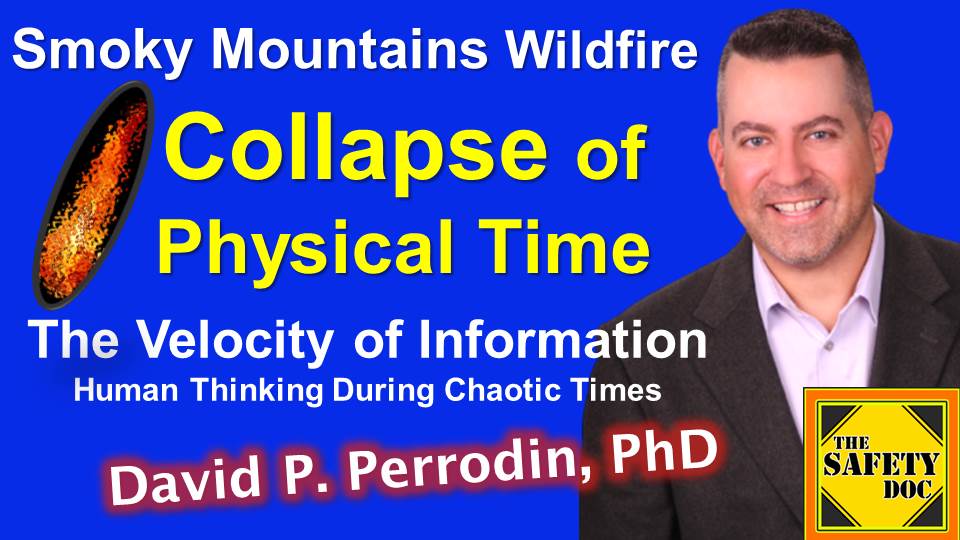Smoky Mountains Wildfire | The Collapse of Physical Time | The Velocity of Information | SDP180
[Podcast] It is legally recognized that time is cleanly divided into years, months, weeks, days, hours, minutes, and seconds. But in certain chaos conditions, the construct of time might distort and collapse into what is known as a flow state. All that matters is the moment. And while we convince ourselves that we will observe and respond to bountiful warning signs, we’ll learn that the collapse of physical time is a hard bifurcation that appears “obvious and avoidable” in hindsight. Such was the case for the 2016 Smoky Mountain Wildfire and the collapse of physical time for hundreds of disoriented, panicked people. In this episode, Doc talks about the collapse of physical time and reads excerpts from pages 10-11 in the book ‘The Velocity of Information – Human Thinking During Chaotic Times’ by David P. Perrodin.

DIRECT LINK to MP3 of this Episode: https://tinyurl.com/SDP180-AUDIO
PIGEON FORGE AND GATLINBURG WILDFIRES. “Consider the wildfires that killed 14 people and destroyed nearly 20,000 acres in the Pigeon Forge and Gatlinburg areas of the Great Smoky Mountains of Eastern Tennessee in November and December 2016. More specifically, imagine being among the residents and vacationers in the Gatlinburg, Tennessee area attempting to flee down the mountainside at night, in the dark, in some cases encountering downed trees and abandoned automobiles blocking roadways, while walls of flame consuming trees and underbrush rapidly approach the road from both sides. “At 8:30 p.m. on November 28, 2016, high winds and roaring flames disabled cell towers, melted fiber-optic cables, disrupted digital radio signals and shut down phone lines. Backup systems and protocols failed.” Everything cut out in an instant.”
LULLED INTO FALSE SENSE OF SECURITY. “Emily Walpole, a NIST scientist who studied the incident, uncovered a perplexing finding in her analysis of the multiday fire. “It’s possible that you get used to smelling smoke and it basically lulls you into a false sense of security . . . the fire could be miles away and be producing smoke.” Likewise, some resorts and vacationers in the area ignored the nearby wildfire threat until it was almost too late. “It seemed that people expected that if a large wildfire requiring evacuation was going to happen, they would be told. Instead, many had to find out on their own.” Resorts closed, issuing eleventh-hour evacuation orders as their hope that the fires would spare their area was extinguished, while the fire was not. One such couple relates how it was not until they texted a picture of encroaching fire to their firefighter son—who replied for them to get out of the area immediately—that their own perception of their immediate situation changed.”
THE FIRE WAS OBSERVED TWO DAYS BEFORE HELL BROKE LOOSE – SO WHY WASN’T THE PUBLIC ALERTED? Survivors blame park rangers and other federal personnel for failing to adequately alert the town about the wildfire’s danger and speed. Insurance companies also have filed litigation in the case. The wildfire started as a small blaze Nov. 23, 2016, the day before Thanksgiving, on the popular Chimney Tops trail in the Great Smoky Mountains National Park. Authorities said it appeared two teenage boys set the fire, which grew in subsequent days until it became an inferno that swept into Gatlinburg on Nov. 28.
INSUFFICIENT NOTIFICATION LAWSUIT CAN CONTINUE. In 2020, Senior U.S. District Judge Ronnie Greer stated that the government failed to properly alert neighbors of the risk of the fire. “The United States cannot rely on the press releases and an E-Blast to satisfy a requirement to notify “Park Neighbors, Park visitors, and local residents” when it doesn’t tell the Court where the press releases and E-Blast were sent to,” Greer wrote. He continued: “Likewise, the United States relies on the information posted to websites and social media accounts to satisfy the requirement. The problem with this argument is the same as the problem with the press release and E-Blast argument. The information posted on the websites gave notice to the visitors of the Park’s website, the Instagram posts may have given notice to the people who follow the Park on Instagram, etc. But posting information on websites and social media accounts is not the same as notifying “Park neighbors, Park visitors and local residents . . . of all planned and unplanned fire management activities that have the potential to impact them.
RELYING ON SMART DEVICES. Many of us rely so heavily on “smart” devices on a daily basis when hell is not breaking loose. We have trained ourselves to assume that the technology that allows us to receive the information we need to navigate our home turf on a typically uneventful day will always work because it always has worked. This assumption is our torus, our normalcy bias. When your observations are mismatched to your technology, choose a course of action to get out of harm’s way.
This is episode 180 of The Safety Doc Podcast published on 05-03-2022. This podcast and blog post represent the opinions of David P. Perrodin and his guests to the show. The content here is for informational purposes only. Please consult with your safety professional regarding the unique needs of yourself or your organization.
FOLLOW
- Watch this episode on “The Safety Doc” YouTube channel https://tinyurl.com/SDP180-VIDEO
- Listen to this episode on PodBean MP3 https://tinyurl.com/SDP180-AUDIO
- Apple Podcasts http://tinyurl.com/SafetyDocApplePodcasts
- SAFETY DOC WEBSITE & BLOG safetyphd.com
- Follow David & The Safety Doc Podcast on Twitter @SafetyPhD
- Email Dr. Perrodin thesafetydoc@gmail.com
Purchase Dr. Perrodin’s books
School of Errors – Rethinking School Safety in America
The Velocity of Information – Human Thinking During Chaotic Times
